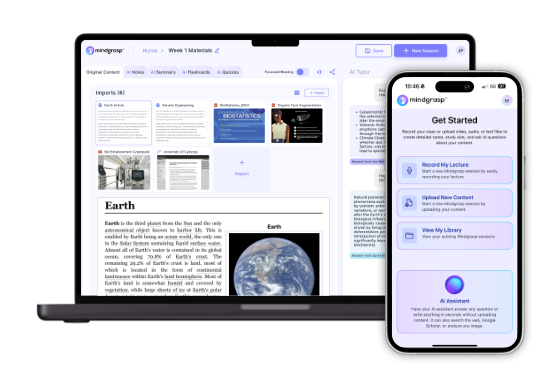
To cram for a political science exam, we need to be strategic.
First, prioritize key theories and concepts from your syllabus and lectures. Don't just re-read notes—use active recall with flashcards and practice questions instead.
Create simple diagrams to connect complex ideas, and take short breaks to stay fresh. Focus on understanding core arguments rather than memorizing everything.
Stay hydrated, get some sleep, and remember—cramming works better when you engage with the material, not just stare at it.
Pressed for time? Use our study guide builder to quickly convert your lecture slides into a personalized study tool for political science exam. Summaries, key points, and more.
Why cramming for political science feels harder than other classes
While most students have pulled all-nighters for various classes, cramming for a political science exam can feel particularly challenging compared to other subjects.
Unlike memorizing formulas or dates, political science demands critical thinking skills that can't be developed overnight.
When we try to rush through complex international relations theories or political frameworks, we're not just memorizing facts – we're attempting to understand interconnected systems and perspectives.
This subject tests our ability to analyze arguments and apply theories to real-world situations, not just regurgitate information.
The subjective nature of political science doesn't help either.
Those essay questions asking us to evaluate democratic systems or compare political movements? They require clear reasoning and evidence – something that's tough to fake when you're running on caffeine and four hours of sleep!
Boost Your GPA Faster with Mindgrasp
Instantly turn your class notes into smart summaries, flashcards, and quizzes—study less, learn more, and ace your exams.
Try it FreeStep 1: Determine what to study (Prioritize high-impact topics)
So you're feeling overwhelmed by political science's complexity—that's totally normal! Let's tackle this strategically by focusing on what matters most.
First, scan your syllabus and any study guides—these are gold mines for identifying key concepts your professor values. We've got to be smart about what we study when time is limited.
Look at your past quizzes and assignments. Where did you struggle? Those areas need extra attention.
Remember to prioritize high-impact topics that:
- Appeared repeatedly in lectures
- Were emphasized by your professor
- Connect to recent political events discussed in class
- Form the foundation for other theories
Don't try to memorize everything! Instead, focus on understanding the core theories and their real-world applications.
Step 2: Gather your political science materials and make a quick plan
The three most important tools for your last-minute study session are right at your fingertips! First, collect everything—textbooks, class notes, and those articles your professor mentioned (you know, the ones you maybe skimmed).
Then, create a simple outline that'll guide your cramming marathon.
Don't waste precious hours reviewing everything! Instead:
- Highlight key theories and concepts that appeared repeatedly in lectures
- Organize materials by exam sections or question types
- Set a timer for each topic (15-30 minutes works well)
Consider joining a study group—explaining concepts to others cements your understanding better than silent reading.
Plus, your classmates might catch something important you missed!
Step 3: Use active recall to study political science (Don’t just re-read)
Toss those passive reading habits aside—they won't save you now! Active recall is your secret weapon for effective learning when time is tight. Instead of simply re-reading your notes (which feels productive but isn't), challenge yourself to retrieve information from memory.
Here's how we'll tackle this:
- Create flashcards for key theories, concepts, and definitions—then quiz yourself mercilessly.
- Use the Feynman technique: explain complex political ideas in simple terms as if teaching a friend.
- Practice answering potential exam questions without peeking at your notes.
- Revisit material you've already studied through quick self-quizzes.
When we force our brains to work harder by pulling information from memory, we're actually strengthening those neural pathways—making recall during the exam much easier!
Step 4: Break down complex political science processes with diagrams
Now that you're equipped with active recall strategies, let's harness the power of visual learning! When cramming for your poli-sci exam, diagrams are absolute lifesavers for simplifying complex ideas.
Try creating:
- Flowcharts to map out political processes (like how a bill becomes law)
- Venn diagrams to compare ideologies (socialism vs. liberalism, anyone?)
- Mind maps connecting related theories
- Simple infographics that condense dense information
We've found that these visual tools dramatically improve understanding and memory retention. When you draw connections between concepts yourself, they stick in your brain way better than just reading them!
For maximum benefit, annotate your diagrams with brief explanations. This forces you to actively engage with the material rather than passively looking at pretty pictures.
Step 5: Leverage AI study tools like Mindgrasp AI for political science
When political science theories start feeling overwhelming, turning to AI tools like Mindgrasp AI can revolutionize your cramming strategy.
Try Mindgrasp for Free!
Experience an easier, faster way to boost your GPA. Sign up now to try Mindgrasp AI for free and see how AI-powered learning transforms your study routine.
Try it FreeWe've found these tools incredibly helpful for last-minute exam prep!
With Mindgrasp AI, you can:
- Generate structured summaries and flashcards to condense those massive readings on political ideologies
- Create personalized quizzes on specific topics (like electoral systems or international relations)
- Visualize complex relationships through mind mapping – perfect for connecting different political theories
Stuck on understanding Gramsci's hegemony or rational choice theory?
Just ask Mindgrasp AI for clarification. The platform even supports spaced repetition techniques, helping you retain more information in less time – exactly what you need when cramming!
These AI study tools transform political science material from overwhelming to manageable.
Step 6: Memorize key terms and definitions with flashcards & mnemonics
Diving into political science memorization doesn't have to feel like climbing Mount Everest! We've found that flashcards are absolute lifesavers for cramming those key terms and definitions.
Create cards with political concepts on one side and explanations on the other, then group related ideas together to build connections.
Mnemonics are your secret weapon too! Create simple acronyms like "D-FCR" for democratic principles (Deliberation, Freedom, Consent, Representation) to make complex ideas stick.
Try quizzing yourself regularly—spacing out practice sessions improves retention dramatically.
For an extra memory boost, add visual elements to your flashcards. A quick sketch or diagram can transform abstract concepts into something your brain enthusiastically grabs onto.
Step 7: Practice with questions and problems
Everyone knows that theory only gets you halfway there—the real magic happens when you start testing yourself!
We've found that practice questions are absolute gold when cramming for political science exams. Hunt down multiple choice questions that mirror your upcoming test format—they'll train your brain to recognize patterns.
Try these quick tactics:
- Grab old exams (professors often reuse question styles)
- Form a study group to quiz each other (explaining answers helps cement concepts)
- Time yourself on practice runs (speed matters on exam day!)
Don't just answer questions—review why you got something wrong. Was it a misunderstood concept? Did you rush?
Each mistake is actually a gift—it shows you exactly where to focus your remaining study time. Trust us, this step separates the A students from the rest!
Step 8: Take short breaks and look after yourself
Most ambitious students make the same critical mistake: trying to cram for hours non-stop.
Trust us, your brain needs regular breaks to process all those political theories and historical events!
We recommend using the Pomodoro Technique — study intensely for 25-30 minutes, then take a short 5-minute break.
During these breaks:
- Stand up and stretch or take a quick walk around your room
- Practice a few deep breaths to reset your mind
- Stay on top of your hydration (keep that water bottle handy!)
Don't underestimate how physical well-being affects your mental performance.
A well-hydrated, rested brain absorbs information much better than an exhausted one.
Remember — cramming effectively isn't just about how much you study, but how smartly you study!
Cramming for political science in 1 Day, 3 Days, or 1 Week
Let's talk about how to tackle political science cramming based on your timeline.
With one week left, you've got enough time to use spaced repetition effectively—reviewing concepts multiple times while building understanding through study groups and practice questions.
If you're down to just three days, you'll need a targeted approach with a day-by-day schedule that prioritizes the most heavily-weighted topics and consistent practice with past exam questions.
For those in the dreaded 24-hour crunch, focus solely on democracy, federalism, and major theories using flashcards and summaries—it's not ideal, but you can still grasp the core concepts that frequently appear on exams.
Cramming for political science with one week left
When you've got a full week before your political science exam, you're in a much better position than those poor souls scrambling with just a day or two left. Let's make the most of it!
First, create a detailed study schedule that divides your week into manageable chunks. Dedicate time to key topics like democracy, federalism, and major political theories.
Don't just reread your notes—use active recall techniques like flashcards and practice quizzes to cement concepts in your memory.
Try condensing lecture notes into concise outlines that show relationships between ideas.
And don't study alone! Group sessions can reveal perspectives you might've missed.
Remember to schedule sleep and breaks too—your brain needs rest to process all that political theory!
Cramming for political science with three days left
Three days before a political science exam might feel like a crisis, but you're actually in a decent position to succeed! We recommend creating a focused plan that targets key questions and concepts like democracy, federalism, and major theoretical frameworks.
Break your three days into specific study blocks:
-
Day 1: Review core concepts and create summary sheets
-
Day 2: Practice with past exams and sample questions
-
Day 3: Join a study group to discuss different perspectives
Don't just memorize—understand the material through active reading techniques. Highlight important points and summarize them in your own words.
For peak performance, be sure to balance intense study with short breaks. Remember, it's better to deeply understand fundamental concepts than to skim everything superficially!
Cramming for political science with one day left (24 hours)
So you've got just 24 hours before your political science exam—don't panic! We're going to make these final hours count.
First, identify the key questions and theories most likely to appear on your exam. Focus on reviewing major concepts rather than trying to learn new material. Create a one-page cheat sheet with definitions, theorists, and significant events.
Practice active recall by quizzing yourself on different types of questions—multiple choice, essay, or short answer—that might appear on your test. This reinforces what you already know.
Break your day into chunks:
-
Morning: Review core theories
-
Afternoon: Practice answering sample questions
-
Evening: Final review of trouble spots
Remember to take short breaks and breathe—your brain needs oxygen to remember Marx's theories!
Common mistakes to avoid when cramming and how to fix them
Although cramming for a political science exam might seem like a good idea at first, it's actually filled with potential pitfalls that can tank your grade.
We've seen students make the same errors repeatedly—like trying to memorize everything in one marathon session. Instead, break your study time into chunks focused on specific topics.
Don't just skim your study materials! Many students forget to practice active recall, which is essential for retention. Try flashcards or self-quizzing to cement those political theories in your brain.
Other common mistakes include:
- Neglecting to review past exam formats
- Skipping breaks (your brain needs rest!)
- Focusing on quantity over understanding
- Letting stress overwhelm you (try deep breathing!)
Fix these issues, and you'll make the most of your limited cramming time.
Final Takeaways on political science cram studying
While cramming isn't ideal, we've discovered that focusing on the right strategies can make a huge difference in your political science exam performance.
Remember to prioritize key concepts like democracy and federalism rather than trying to memorize everything.
We recommend these quick tips:
- Use flashcards for active recall of important definitions
- Focus on answering key questions that might appear on the exam
- Consider different perspectives on major debates
- Study in groups to clarify misunderstandings
- Break study sessions into manageable chunks (try the Pomodoro technique!)
When time is limited, quality beats quantity.
By zeroing in on what matters most and using active learning techniques, you'll maximize what you can absorb in those final hours before the exam.
Good luck!
Download Mindgrasp from the App Store
Access Mindgrasp at your desk for in-depth research and writing projects, or use the mobile version to easily access your content on-the-go or record live lectures.
Download the iOS App
